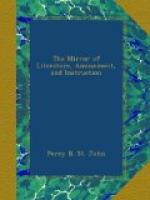A reckless Rover, ’mid death and
doom,
Pass’d a soldier, his
plunder seeking:
Careless he stept where friend and foe
Lay alike in their life-blood
reeking.
Drawn by the shine of the warrior’s
sword,
The soldier paused beside
it:
He wrench’d the hand with a giant’s
strength,
But the grasp of the dead
defied it.
He loosed his hold, and his English heart
Took part with the dead before
him,
And he honour’d the brave who died
sword in hand,
As with soften’d brow
he leant o’er him.
“A soldier’s death thou hast
boldly died,
A soldier’s grave won
by it:
Before I would take that sword from thine
hand,
My own life’s blood
should dye it.
“Thou shalt not be left for the
carrion crow,
Or the wolf to batten o’er
thee:
Or the coward insult the gallant dead,
Who in life had trembled before
thee.”
Then dug he a grave in the crimson earth
Where his warrior foe was
sleeping,
And he laid him there in honour and rest,
With his sword in his own
brave keeping.
* * * * *
As a relief, we quote the following characteristic sketch by Miss Mitford:—
A COUNTRY APOTHECARY.
One of the most important personages in a small country town is the apothecary. He takes rank next after the rector and the attorney, and before the curate; and could be much less easily dispensed with than either of those worthies, not merely as holding “fate and physic” in his hand, but as the general, and as it were official, associate, adviser, comforter, and friend, of all ranks and all ages, of high and low, rich and poor, sick and well. I am no despiser of dignities; but twenty emperors shall be less intensely missed in their wide dominions, than such a man as my friend John Hallett in his own small sphere.
The spot which was favoured with the residence of this excellent person was the small town of Hazelby, in Dorsetshire; a pretty little place, where every thing seems at a stand-still. It was originally built in the shape of the letter T; a long broad market-place (still so called, although the market be gone) serving for the perpendicular stem, traversed by a straight, narrow, horizontal street, to answer for the top line. Not one addition has occurred to interrupt this architectural regularity, since, fifty years ago, a rich London tradesman built, at the west end of the horizontal street, a wide-fronted single house, with two low wings, iron palisades before, and a fish-pond opposite, which still goes by the name of New Place, and is balanced, at the east end of the street, by an erection of nearly the same date, a large square dingy mansion enclosed within high walls, inhabited by three maiden sisters, and called, probably by way of nickname, the Nunnery. New Place being on the left of the road,




